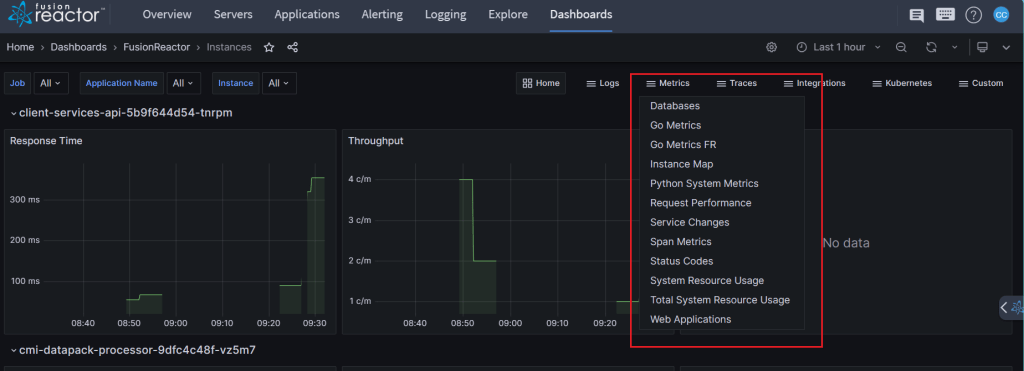What’s new in FusionReactor
In this update, we are thrilled to unveil a host of enhancements designed to revolutionize your experience with our platform. From streamlined dashboard navigation to a reimagined Server view, FusionReactor is committed to providing powerful data insights and a seamless monitoring and troubleshooting experience.
What’s new:
Enhanced dashboard navigation
We’re thrilled to introduce some exciting enhancements to our dashboards, providing you with even more powerful data insights! Our latest update has improved the user experience by allowing variables and time picker settings to pass between dashboards seamlessly. Our update will enable you to move quickly between dashboards, ensuring you never lose context while exploring your data, as all filters and time values are retained as you switch dashboards. To make navigation a breeze, we’ve improved the search facilities, allowing you to locate any dashboard you require effortlessly. The newly incorporated dropdown dashboard links make accessing the information you need more accessible than ever. These updates are designed to streamline your dashboard experience and empower you to make data-driven decisions effortlessly.
Servers update
We’re excited to unveil the latest enhancements to FusionReactor’s server view, designed with On-Prem parity to elevate your monitoring and troubleshooting experience. Our team has diligently worked to make the server’s view more transparent and more accessible than ever before. With a refreshed interface, intuitive navigation, and streamlined information presentation, gaining insights into your server’s performance has never been easier. Whether you’re a seasoned developer or just starting your journey, you’ll appreciate the enhanced visibility into key metrics, real-time updates, and advanced analytics, all thoughtfully organized for effortless comprehension. Say goodbye to complexity and hello to a reimagined Servers view that empowers you to optimize your application’s performance efficiently.
Coming soon:
FusionReactor 11
FusionReactor, the renowned application performance monitoring (APM) tool, is gearing up to release FusionReactor 11. This upcoming release promises a significant improvement in security updates, reflecting the company’s commitment to keeping your applications safe and secure. However, one notable change in this release is the discontinuation of Java 7 support, a decision made to address critical CVEs (Common Vulnerabilities and Exposures).
OpsPilot AI Assistant
FusionReactor’s latest innovation, the OpsPilot AI Assistant, is a game-changer for productivity. This cutting-edge assistant harnesses the power of generative and causal AI, empowering users to achieve higher levels of efficiency and effectiveness in managing their systems. What’s even more exciting is that OpsPilot AI Assistant is continuously evolving. Soon, it will offer continuous forecasting and anomaly prediction capabilities, encompassing multidimensional baselines, application traffic, and service load. Notably, it is highly attuned to all seasonality and patterns, making it an invaluable tool for proactive system optimization and performance enhancement. This development reinforces FusionReactor’s commitment to staying at the forefront of technological advancements in the realm of application performance monitoring.
Anomaly detection
Our latest anomaly detection enhancements include a new panel that provides insights into read/write rates and the total number of metric values processed by anomaly detection services, giving you a comprehensive view of system performance. Moreover, we’ve added support for user-defined time ranges in queries, allowing you to customize your anomaly detection settings.
Deep
FusionReactor is in the process of adding an insightful tool for developers to the platform. The new Deep integration will provide AI-powered root cause analysis to help solve issues quickly and instantly debug in production without requiring restart or redeploying. With Deep, your team can concentrate on delivering innovative features rather than spending valuable time debugging.
About FusionReactor
In this era of technological advancement, it’s paramount to have a holistic perspective of your system and attain complete stack observability. You need three essential data types to achieve this: metrics, logs, and traces. Nevertheless, it’s insufficient merely to gather this telemetry data. The key lies in comprehending the connections between data points, and for this purpose, FusionReactor becomes indispensable.
FusionReactor is a comprehensive stack observability solution that establishes and sustains profound insights into these associations. With FusionReactor, you can seamlessly examine, visualize, and resolve issues across your entire system from a unified platform. This potent tool furnishes you with extensive insights and integrates generative AI, utilizing natural language for monitoring assistance.
Through OpsPilot, you can revolutionize how you oversee and manage your applications, enabling you to delve into performance concerns with unparalleled precision swiftly. We empower you to contextualize your system’s health swiftly by pinpointing and eradicating issues, ultimately culminating in a more consistent end-user experience.













